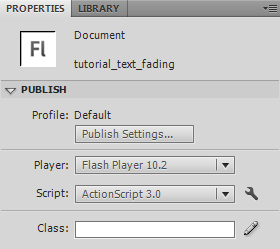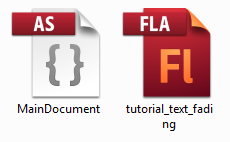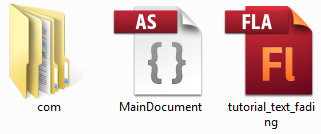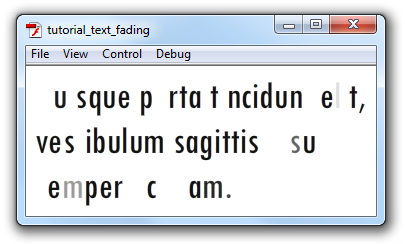|
by
kirupa | 16 June 2011
Have questions? Discuss this Flash tutorial with
others on the forums.
In the
previous page, with a few detours along the way,
you created the text whose letters you want faded out. In
this and subsequent pages, let's add the code and learn more about how it
works!
The first thing we need to do is associate a class whose
code will execute automatically when our SWF file is run.
The way you do this is by specyfing your
document class. Click on any empty area of your artboard
to display the document's properties in the Properties
Panel:

[ get the document class ready ]
In the Class field, enter the name MainDocument
and click on the pencil icon found next to it. You'll now be
in AS file editing mode. Hit Ctrl + S or go to File | Save
to save this file as MainDocument.as into the same folder as
where your FLA is saved:

Everytime your SWF file is run, the code in MainDocument
gets executed. This means that the code we would want to
start our animation can happily live here.
Your
MainDocument class connects the visual part of what you have
done with the code part that you will be doing. In this
section, let's fully add the code that will fade the letters
in our text out so that you have a working example. We will
then go through and look at why the code works the way it
does!
First, overwrite all of the contents inside your
MainDocument class with the following code:
- package
- {
-
- import
flash.display.MovieClip;
- import
flash.utils.Timer;
- import
flash.events.TimerEvent;
- import
com.greensock.TweenLite;
- import
com.greensock.easing.*;
-
- public
class
MainDocument
extends
MovieClip
- {
-
- var
animationSeconds:Number
=
1;
- var
delayMilliseconds:Number
=
100;
-
- var
currentCount:Number
=
0;
-
- var
letters:Array;
- var
timer:Timer;
-
- public
function
MainDocument()
- {
- Setup();
- }
-
- public
function
Setup()
- {
- letters
=
new
Array();
-
- for
(var
i:int
=
0;
i
<
textClip.numChildren;
i++)
- {
- letters.push(textClip.getChildAt(i));
- }
- ShuffleArray(letters);
- SetupTimer();
- }
-
- public
function
SetupTimer()
- {
- timer
=
new
Timer(delayMilliseconds);
- timer.addEventListener(TimerEvent.TIMER,
TimerTick);
- timer.start();
- }
-
- public
function
TimerTick(e:TimerEvent)
- {
- if
(currentCount
<
letters.length)
- {
- AnimateLetter();
- }
- else
- {
- timer.stop();
- timer.removeEventListener(TimerEvent.TIMER,
TimerTick);
- }
- }
- public
function
ShuffleArray(input:Array)
- {
- for
(var
i:int
=
input.length-1;
i
>=0;
i--)
- {
- var
randomIndex:int
=
Math.floor(Math.random()
*
(i
+
1));
- var
itemAtIndex:Object
=
input[randomIndex];
-
- input[randomIndex]
=
input[i];
- input[i]
=
itemAtIndex;
- }
- }
-
- public
function
AnimateLetter()
- {
- TweenLite.to(letters[currentCount],
animationSeconds,
{alpha:0,
ease:Cubic.easeIn});
- currentCount++;
- }
- }
-
- }
You are not quite done yet. This code relies on the
TweenLite library to perform the animations, so make
sure to download the TweenLite library and copy the
com folder and paste in the same directory as your FLA and
MainDocument.as
file:

If you are not sure how to do this, do check out my
introductory
Animating with TweenLite tutorial that goes into greater
detail on this.
Once you have your com folder from the TweenLite library
copied/pasted into the same location as the rest of your
files, you are good to go. If
you press Ctrl+Enter or Control | Test Movie | Test, you
will see letters from your text fading out:

[ your example should work now! ]
Ok, now that you have a working example, let's start
figuring out why it actually works by looking at the
code...on the
next page.
Onwards to the
next page!
|